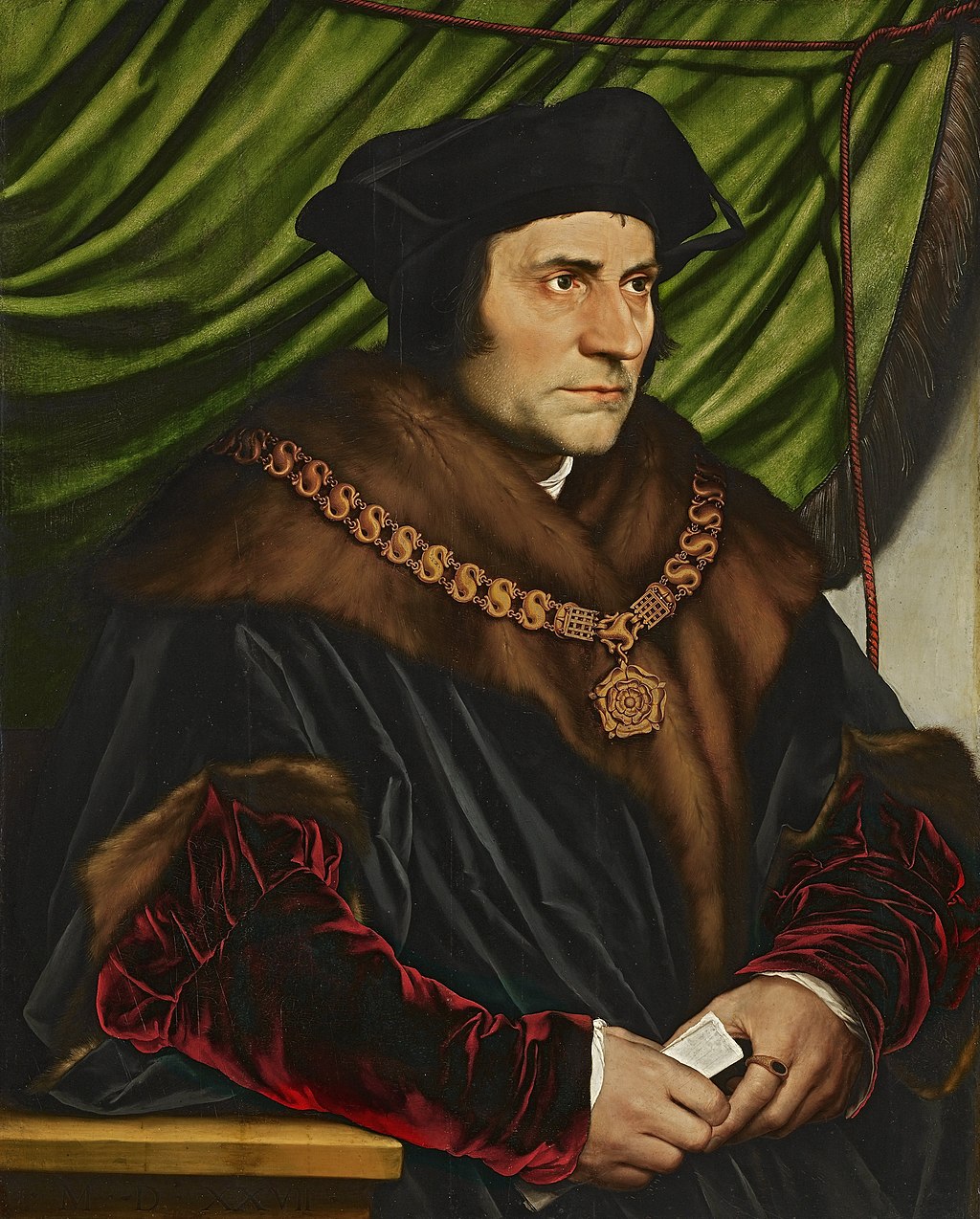
“Sir Thomas More” by Hans Holbein the Younger, was created soon after Holbein arrived in London. Holbein’s friend, the Dutch humanist Desiderius Erasmus, recommended that Holbein befriend More, who was then a powerful, knighted speaker at the English Parliament.
Moore played a prominent role during his lifetime, and his courageous actions echo down through history. Pope Pius XI canonized Thomas More in 1935 as a martyr.
Pope John Paul II in 2000 declared him the “heavenly Patron of Statesmen and Politicians.”
The Soviet Union honored him for his attitude toward property rights expressed in his book Utopia, which is about the political system of an imaginary, ideal island nation, published in 1516
Thomas More was an English lawyer, social philosopher, author, statesman, and noted Renaissance humanist. He was also a counselor to Henry VIII, and Lord High Chancellor of England from October 1529 to 1532.
More opposed the Protestant Reformation. He also opposed the king’s separation from the Catholic Church, refusing to acknowledge King Henry VIII as Supreme Head of the Church of England and the annulment of his marriage to Catherine of Aragon.
After refusing to take the Oath of Supremacy, he was convicted of treason and beheaded. Of his execution, he was reported to have said:
“I die the King’s good servant, and God’s first.”
This portrait is closely related to drawings in the Royal Collection, and there is a copy of this painting in the National Portrait Gallery.
Another Holbein portrait of More, part of a large group portrait of his family, is now lost, but several drawings copies survive.
Sir Thomas More’s execution took place in 1535. On the scaffold, More recited the Miserere, Psalm 51 in which God’s mercy is sought.
While kneeling, the executioner begged his pardon, More rose, kissed him, and gave him forgiveness. His headless body was buried at the Tower of London, in an unmarked grave.
His head was fixed upon a pike over London Bridge for a month, according to the custom for traitors.
Psalm 51 which Thomas More recited before his Execution, King James Version (KJV)
“Have mercy upon me, O God, according to thy lovingkindness:
according unto the multitude of thy tender mercies blot out my transgressions.
Wash me thoroughly from mine iniquity, and cleanse me from my sin.
For I acknowledge my transgressions: and my sin is ever before me.”
The 51st psalm of the Book of Psalms is traditionally known as the Miserere, especially in musical settings. Psalm 51 is one of the Penitential Psalms, composed by David as a confession to God after he sinned with Bathsheba.
The psalm is a regular part of Jewish, Catholic, Eastern Orthodox, and Protestant liturgies. It is the most often quoted psalm in the Eastern Orthodox and Byzantine Catholic Churches: “Have mercy upon me, O God.”
Hans Holbein the Younger
Hans Holbein the Younger, worked in a Northern Renaissance style and is recognized as one of the greatest portraitists of the 16th century.
He also produced religious art, satire, and Reformation propaganda. He is called “the Younger” to distinguish him from his father, Hans Holbein the Elder, an accomplished painter of the Late Gothic school.
Holbein traveled to England in 1526 and was welcomed into the humanist circle of Thomas More, where he quickly built a high reputation.
Later, he also worked under the patronage of Anne Boleyn and Thomas Cromwell. By 1535, he was King’s Painter to King Henry VIII.
His portraits of the royal family and nobles are a historical visual record of the court during the years when Henry was asserting his supremacy over the English church.
Holbein’s fame is based in no small degree for his portraits have become cultural icons.
He created the most memorable images of Henry VIII and Holbein’s portraits of other historical figures, such as Erasmus, Thomas More, and Thomas Cromwell. He made their pictures the official images for posterity.
The same is true for a range of English lords and ladies whose importance is often only known through his art. Holbein has been referred to as the cameraman of Tudor history.
In Germany, where he grew up and studied, Holbein is regarded as an artist of the Reformation and Humanism.
Hans Holbein died between in 1543 at the age of 45, the site of Holbein’s grave is unknown and may never have been marked.
Sir Thomas More
- Title: Sir Thomas More
- Artist: Hans Holbein the Younger
- Created: 1527
- Medium: oil on oak panel
- Dimensions: Height: 74.9 cm (29.5 in). Width: 60.3 cm (23.7 in).
- Museum: Frick Collection, New York
Hans Holbein the Younger
- Name: Hans Holbein the Younger
- Born: c. 1497 – Augsburg, Free imperial city, Holy Roman Empire
- Died: 1543 (aged 45) – London, England
- Nationality: German Swiss
- Movement: Northern Renaissance
- Notable work:
- Sir Thomas More
- Portrait of Henry VIII of England
- The Ambassadors
- Portrait of Thomas Cromwell
- Self-Portrait
Hans Holbein, the Younger, “Sir Thomas More”
Virtual Tour of the Frick Collection
- “Saint Francis in the Desert” by Giovanni Bellini
- “Sir Thomas More” by Hans Holbein the Younger
- “Portrait of Thomas Cromwell” by Hans Holbein the Younger
- “Saint Jerome as Scholar” by El Greco
- “The Polish Rider” by Rembrandt
- “Harmony in Pink and Grey” by James Abbott McNeill Whistler
Hans Holbein the Younger’s portrait of Sir Thomas More
Hans Holbein the Younger
~~~
“I die the king’s faithful servant, but God’s first.”
– Thomas More
~~~
Photo Credit 1) Hans Holbein [Public domain], via Wikimedia Commons
Popular this Week








 Sponsor your Favorite Page
Sponsor your Favorite Page SEARCH Search for: Search Follow UsJoin – The JOM Membership Program
Sponsor a Masterpiece with YOUR NAME CHOICE for $5
Share this:
- Tweet
